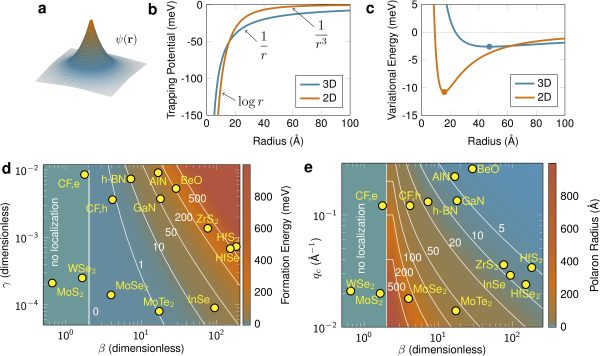News Express: UM Macao Fellow’s study in solid-state physics published in top international journal
新聞快訊:澳大濠江學者固體物理研究獲國際頂級期刊刊登
—


a)二維極子波包示意圖,b ) 自陷勢阱(二維 vs. 三維),c)極子基態能量 vs. 半徑(二維 vs. 三維), d)二維材料中的電洞極子基態形成能,及 e)二維材料中的電洞極子半徑
a) Schematic illustration of a polaron wave packet; b) Self-trapped potential (2D vs 3D); c) Ground state energy of polarons vs radius (2D vs 3D); d) Formation energy of hole polaron in 2D materials; and e) Radius of hole polaron in 2D materials
澳大濠江學者固體物理研究獲國際頂級期刊刊登
澳門大學應用物理及材料工程研究院(IAPME)的澳大濠江學者蕭詠康博士與美國德州大學奧斯汀分校物理系的科研合作取得重大進展,首次在超級計算機輔助模擬下於二維類石墨烯原子晶體—單層氮化硼上觀察到二維弗勒利希極子並預測出其基態能量,有助設計更具效能的量子材料及光電器件。相關研究成果獲國際頂級科學期刊《自然—物理學》(Nature Physics) 刊登。
極子作為一種在量子場論框架下描述的準粒子,被認為與多種材料物理現象相關聯。上世紀30年代由前蘇聯物理學家朗道預言,及後其物理模型經過博戈柳博夫、李政道、費曼等著名高能物理學家逐漸拓展。然而,上世紀50年代由於高性能計算機及電子結構理論尚未成熟,極子理論模型的構建多以簡化的連續電介質模型描述固體晶格結合數學解析方法,以致早期建立的極子模型應用在半導體材料上的預測並不準確。
為此,研究團隊建立了一套在二維及三維空間皆通用的電子—聲子相互作用計算框架,闡明了電子與聲子在二維材料中的長程相互作用形式,並以此為基礎開發出一種新型的計算方法,能夠克服目前直接以第一性原理密度泛涵方法模擬二維極子會遭遇庫侖發散的難題。該方法成功還原極子自陷態在不同二維材料載體下的幾何形貌,並精確計算出其半徑及基態能量。由於在自然界中晶格缺陷的存在非常普遍,透過引入能影響半導體材料特質的摻雜物(Dopants),其電子往往會在缺陷中形成極子並使材料產生畸變效應(Distortion Effects),從而改變材料的光電性質。該項研究成果未來或能協助工程師設計出更具效能的量子材料及光電器件。
此外,文中亦提出二維極子自陷勢阱的數學模型,該模型指出局域化極子在二維材料中的基態能量取決於三個獨立物理量,分別為電子的有效質量、二維材料的有效厚度及離子介電屏蔽,並給出其數學公式。其中,文中特別指出電子能否在二維材料上形成局域化極子取決於上述三個物理參數的權衡,而過去在三維材料的極子研究中則沒有發現對應的物理規律。該模型不僅完善了早期發展的極子理論,而且期望能為實驗物理學家攢選出合適的候選材料來進行相關實驗,為超導材料、固態量子比特、單光子源器件及光催化等應用研究提供所需的理論基礎。上述科研成果通過嚴格的同行評審獲發表在《自然—物理學》上。
研究《二維原子晶體中的極子》“Polarons in two-dimensional atomic crystals”由蕭詠康與美方科學家 Feliciano Giustino 二人共同撰文完成。當中關鍵的技術驗證通過位於美國德州大學的超級計算機—孤星六以數千個CPU計算核心來實現,模擬的原子數目規模達到10萬個,並行計算程序由蕭博士獨立開發完成。該研究得到澳大 “澳大濠江學者” 、澳門特別行政區科學技術發展基金(檔案編號:0102/2019/A2; 潘暉教授提供相關項目資源)。另外,中國呂梁雲計算中心及美國德州大學TACC超級計算中心提供上述研究所需的算力支持。全文可瀏覽以下網頁:https://www.nature.com/articles/s41567-023-01953-4
欲瀏覽官網版可登入以下連結:
https://www.um.edu.mo/zh-hant/news-and-press-releases/campus-news/detail/55178/
UM Macao Fellow’s study in solid-state physics published in top international journal
UM Macao Fellow Sio Weng Hong in the Institute of Applied Physics and Materials Engineering (IAPME), University of Macau (UM), has made significant progress in a research collaboration with the Department of Physics, University of Texas at Austin. The research team has for the first time observed two-dimensional Frohlich polarons on a boron nitride monolayer, a graphene-like atomic crystal, with the aid of a supercomputer, and predicted the ground state energy of the polarons. The discovery may help design more efficient quantum materials and optoelectronic devices. The research results have been published in the top international journal Nature Physics.
As a class of quasiparticles described under the framework of quantum field theory, polarons are considered to be related to many physical phenomena of materials. It was first predicted by the Soviet physicist, Lev Landau, in the 1930s, and its physical model has been gradually developed by pioneers in high energy physics, such as Nikolay Bogolyubov, Lee Tsung-Dao and Richard Feynman. However, the early formulation of polaron theories mostly used simplified dielectric continuum models in combination with simple mathematical analysis to describe crystal lattices, because of the immaturity of high-performance computers and electronic structure theory in the 1950s. This had led to inaccurate predictions when the early established polaron models were applied to study semiconducting materials.
The research team has established a general framework to compute electron-phonon interactions in both two-dimensional (2D) and three-dimensional (3D) spaces, and clarified the analytical form of long-range interactions between electrons and phonons in 2D materials. Based on this advancement, a new computational method was subsequently proposed to overcome the problem of Coulomb divergence occurred when simulating 2D materials directly with first-principles density functional theory. This method successfully rendered the geometrical details of the polaronic self-trapped state in different 2D hosting materials, and accurately calculated its radius and the ground state energy. Since the existence of lattice defects is commonly found in nature, electrons from dopants that affect the properties of semiconducting materials are often trapped in the defect site to form polarons and induce distortion effects in the hosting material, which in turn renormalises the photoelectric properties of the host. The research results may help engineers design more efficient quantum materials and optoelectronic devices in the future.
In addition, the study proposed a mathematical model of the 2D self-trapped potential, which indicates that the ground state energy of localised polarons in two-dimensional materials depends on three independent physical quantities, namely the effective mass of electron, the effective thickness of 2D material, and the ionic dielectric screening. Its mathematical formula is also given in the article. In addition, the article specifically pointed out that whether an electron in 2D materials can form a localised polaron depends solely on the trade-off between the three physical quantities, and no corresponding laws of physics were found in previous studies of polarons in bulk 3D materials. The proposed model has not only completed the missing piece of modern polaron theories, it is also expected to aid experimental physicists to screen suitable candidates for related studies and provide the required theoretical foundation for practical applications such as superconducting materials, solid-state qubits, single-photon source devices, and photocatalyses. The research results have been published in Nature Physics after a rigorous peer review process.
Titled ‘Polarons in Two-dimensional Atomic Crystals’, the article was co-authored by Dr Sio and the US scientist Feliciano Giustino. The key validation of the discovery was realised by the supercomputer Lonestar 6 at the University of Texas at Austin with thousands of CPU cores. The number of simulated atoms reached 100,000 and the parallel computing program was developed independently by Dr Sio. The study was supported by the UM Macao Fellow scheme of the university and the Science and Technology Development Fund of the Macao SAR (File no: 0102/2019/A2, with Prof Pan Hui providing relevant project resources). In addition, LvLiang Cloud Computing Center in China and the Texas Advanced Computing Center at the University of Texas at Austin provided computing power support for this study. The full-version of the article can be viewed at https://www.nature.com/articles/s41567-023-01953-4.
To read the news on UM’s official website, please visit the following link:
https://www.um.edu.mo/news-and-press-releases/campus-news/detail/55178/